2004 CHRYSLER VOYAGER windshield wipers
[x] Cancel search: windshield wipersPage 2162 of 2585
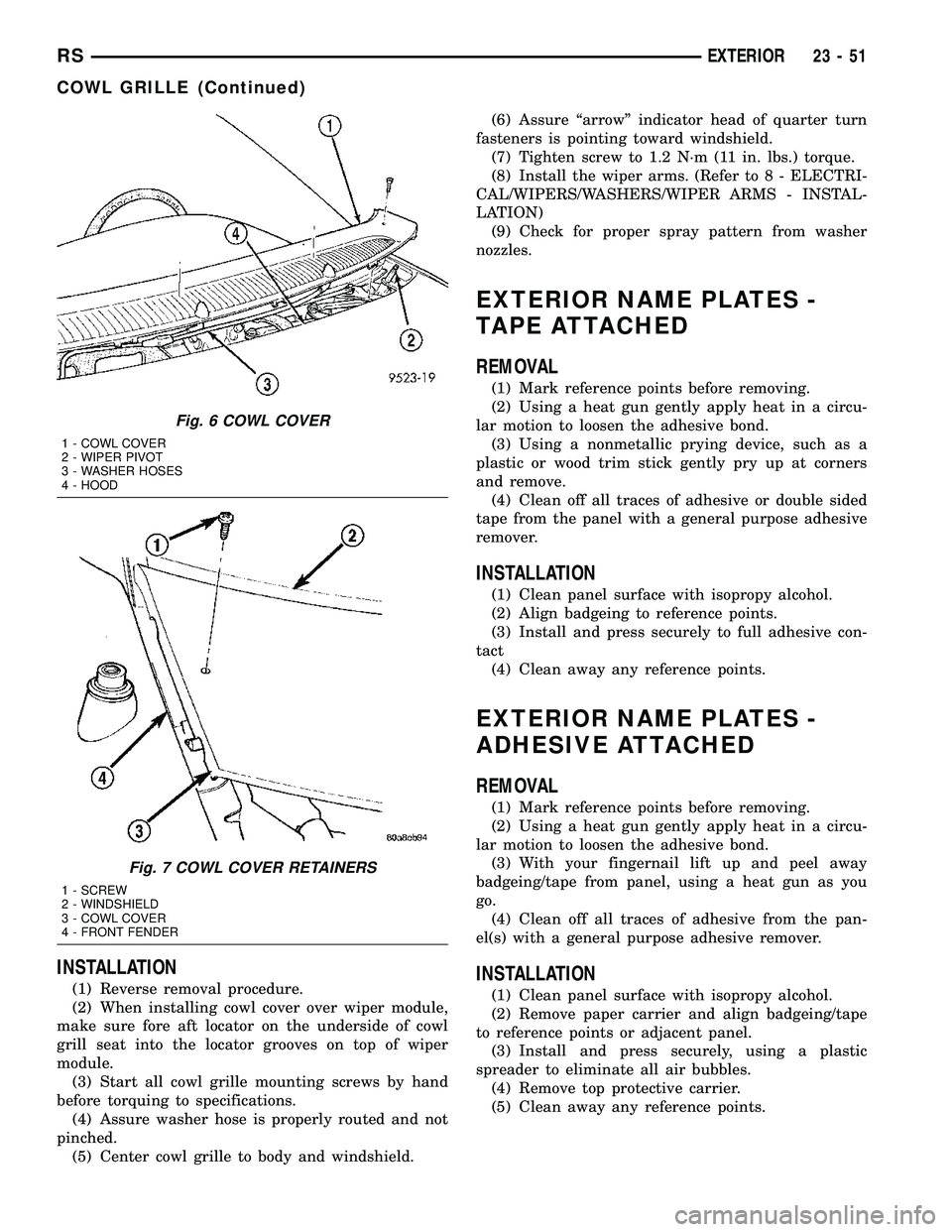
INSTALLATION
(1) Reverse removal procedure.
(2) When installing cowl cover over wiper module,
make sure fore aft locator on the underside of cowl
grill seat into the locator grooves on top of wiper
module.
(3) Start all cowl grille mounting screws by hand
before torquing to specifications.
(4) Assure washer hose is properly routed and not
pinched.
(5) Center cowl grille to body and windshield.(6) Assure ªarrowº indicator head of quarter turn
fasteners is pointing toward windshield.
(7) Tighten screw to 1.2 N´m (11 in. lbs.) torque.
(8) Install the wiper arms. (Refer to 8 - ELECTRI-
CAL/WIPERS/WASHERS/WIPER ARMS - INSTAL-
LATION)
(9) Check for proper spray pattern from washer
nozzles.
EXTERIOR NAME PLATES -
TAPE ATTACHED
REMOVAL
(1) Mark reference points before removing.
(2) Using a heat gun gently apply heat in a circu-
lar motion to loosen the adhesive bond.
(3) Using a nonmetallic prying device, such as a
plastic or wood trim stick gently pry up at corners
and remove.
(4) Clean off all traces of adhesive or double sided
tape from the panel with a general purpose adhesive
remover.
INSTALLATION
(1) Clean panel surface with isopropy alcohol.
(2) Align badgeing to reference points.
(3) Install and press securely to full adhesive con-
tact
(4) Clean away any reference points.
EXTERIOR NAME PLATES -
ADHESIVE ATTACHED
REMOVAL
(1) Mark reference points before removing.
(2) Using a heat gun gently apply heat in a circu-
lar motion to loosen the adhesive bond.
(3) With your fingernail lift up and peel away
badgeing/tape from panel, using a heat gun as you
go.
(4) Clean off all traces of adhesive from the pan-
el(s) with a general purpose adhesive remover.
INSTALLATION
(1) Clean panel surface with isopropy alcohol.
(2) Remove paper carrier and align badgeing/tape
to reference points or adjacent panel.
(3) Install and press securely, using a plastic
spreader to eliminate all air bubbles.
(4) Remove top protective carrier.
(5) Clean away any reference points.
Fig. 6 COWL COVER
1 - COWL COVER
2 - WIPER PIVOT
3 - WASHER HOSES
4 - HOOD
Fig. 7 COWL COVER RETAINERS
1 - SCREW
2 - WINDSHIELD
3 - COWL COVER
4 - FRONT FENDER
RSEXTERIOR23-51
COWL GRILLE (Continued)
Page 2221 of 2585
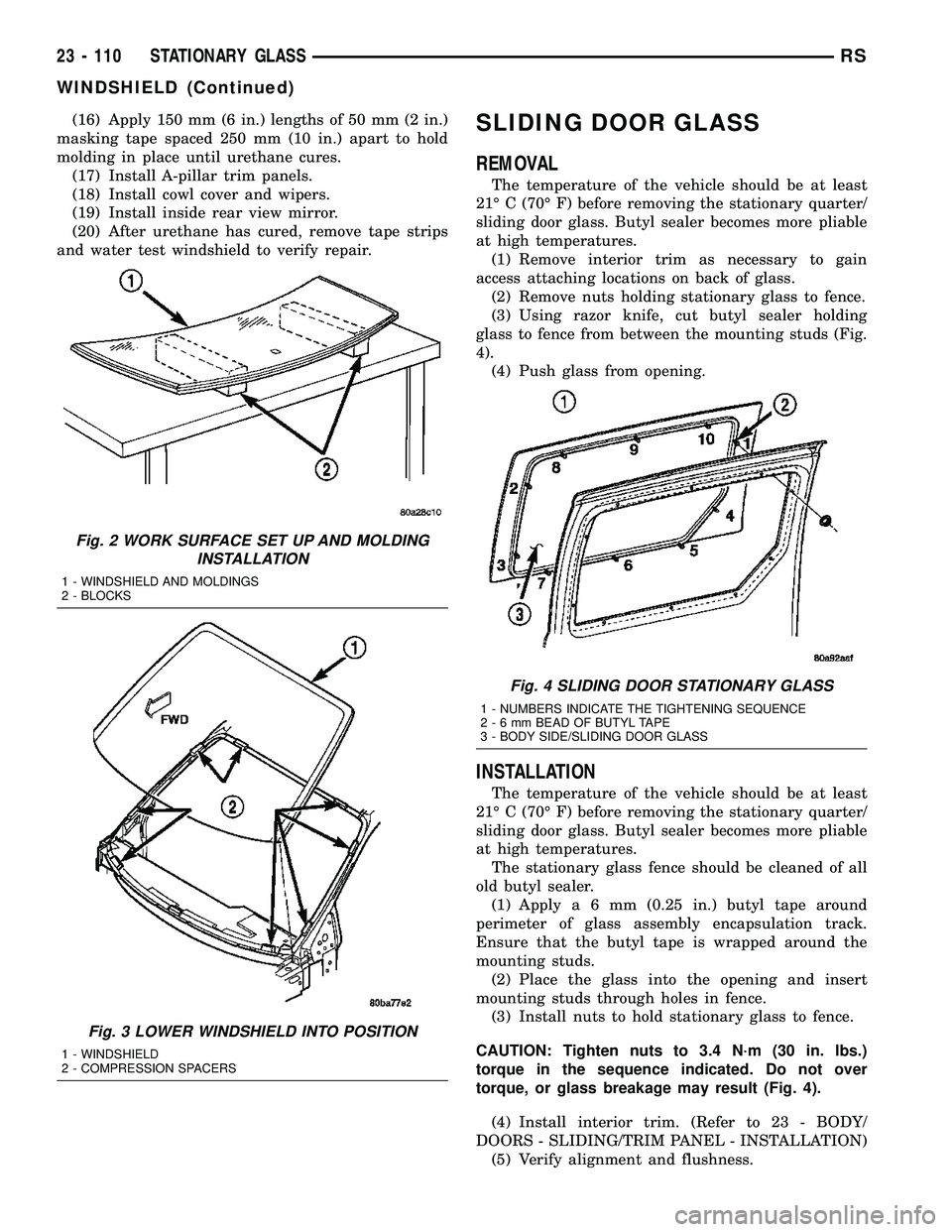
(16) Apply 150 mm (6 in.) lengths of 50 mm (2 in.)
masking tape spaced 250 mm (10 in.) apart to hold
molding in place until urethane cures.
(17) Install A-pillar trim panels.
(18) Install cowl cover and wipers.
(19) Install inside rear view mirror.
(20) After urethane has cured, remove tape strips
and water test windshield to verify repair.SLIDING DOOR GLASS
REMOVAL
The temperature of the vehicle should be at least
21É C (70É F) before removing the stationary quarter/
sliding door glass. Butyl sealer becomes more pliable
at high temperatures.
(1) Remove interior trim as necessary to gain
access attaching locations on back of glass.
(2) Remove nuts holding stationary glass to fence.
(3) Using razor knife, cut butyl sealer holding
glass to fence from between the mounting studs (Fig.
4).
(4) Push glass from opening.
INSTALLATION
The temperature of the vehicle should be at least
21É C (70É F) before removing the stationary quarter/
sliding door glass. Butyl sealer becomes more pliable
at high temperatures.
The stationary glass fence should be cleaned of all
old butyl sealer.
(1) Applya6mm(0.25 in.) butyl tape around
perimeter of glass assembly encapsulation track.
Ensure that the butyl tape is wrapped around the
mounting studs.
(2) Place the glass into the opening and insert
mounting studs through holes in fence.
(3) Install nuts to hold stationary glass to fence.
CAUTION: Tighten nuts to 3.4 N´m (30 in. lbs.)
torque in the sequence indicated. Do not over
torque, or glass breakage may result (Fig. 4).
(4) Install interior trim. (Refer to 23 - BODY/
DOORS - SLIDING/TRIM PANEL - INSTALLATION)
(5) Verify alignment and flushness.
Fig. 2 WORK SURFACE SET UP AND MOLDING
INSTALLATION
1 - WINDSHIELD AND MOLDINGS
2 - BLOCKS
Fig. 3 LOWER WINDSHIELD INTO POSITION
1 - WINDSHIELD
2 - COMPRESSION SPACERS
Fig. 4 SLIDING DOOR STATIONARY GLASS
1 - NUMBERS INDICATE THE TIGHTENING SEQUENCE
2-6mmBEAD OF BUTYL TAPE
3 - BODY SIDE/SLIDING DOOR GLASS
23 - 110 STATIONARY GLASSRS
WINDSHIELD (Continued)
Page 2423 of 2585
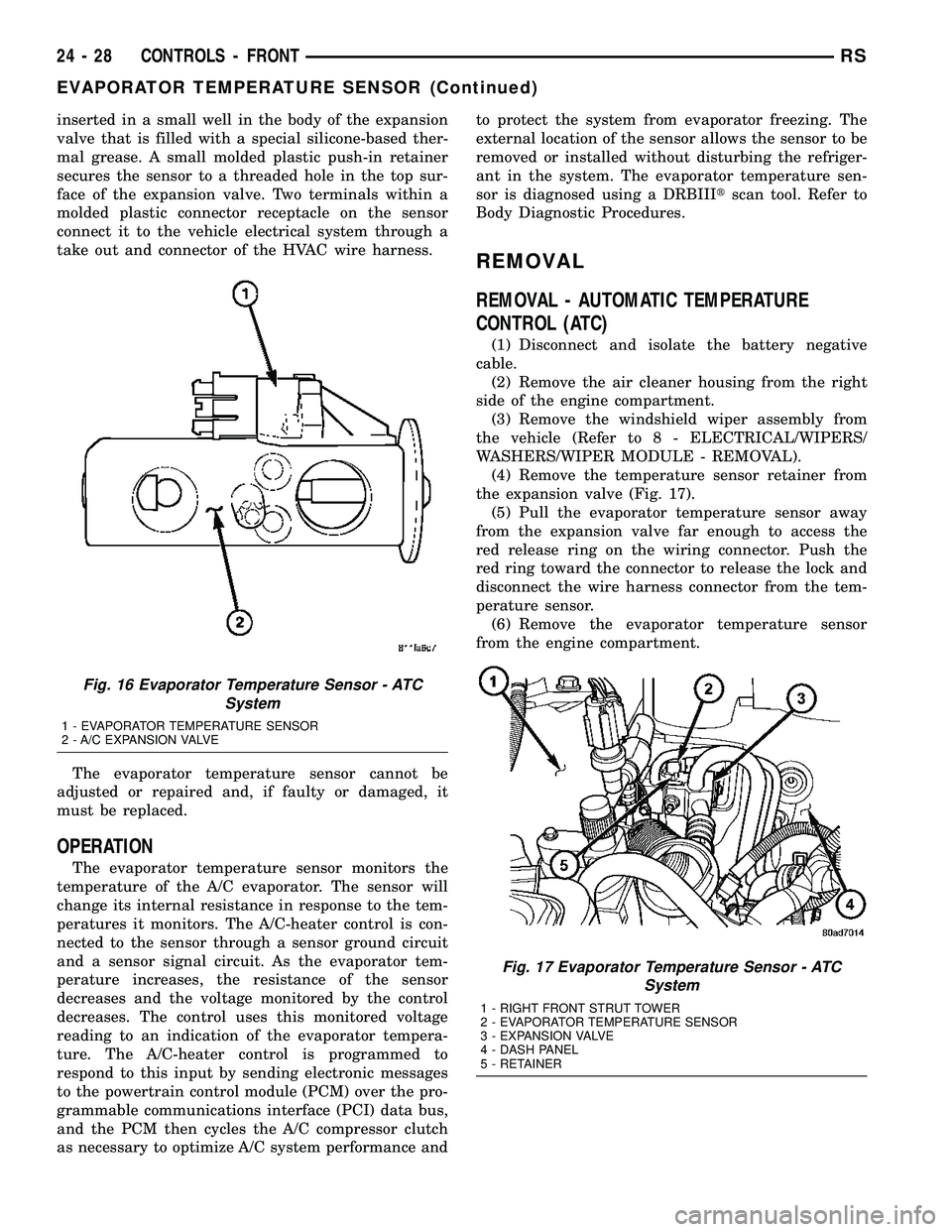
inserted in a small well in the body of the expansion
valve that is filled with a special silicone-based ther-
mal grease. A small molded plastic push-in retainer
secures the sensor to a threaded hole in the top sur-
face of the expansion valve. Two terminals within a
molded plastic connector receptacle on the sensor
connect it to the vehicle electrical system through a
take out and connector of the HVAC wire harness.
The evaporator temperature sensor cannot be
adjusted or repaired and, if faulty or damaged, it
must be replaced.
OPERATION
The evaporator temperature sensor monitors the
temperature of the A/C evaporator. The sensor will
change its internal resistance in response to the tem-
peratures it monitors. The A/C-heater control is con-
nected to the sensor through a sensor ground circuit
and a sensor signal circuit. As the evaporator tem-
perature increases, the resistance of the sensor
decreases and the voltage monitored by the control
decreases. The control uses this monitored voltage
reading to an indication of the evaporator tempera-
ture. The A/C-heater control is programmed to
respond to this input by sending electronic messages
to the powertrain control module (PCM) over the pro-
grammable communications interface (PCI) data bus,
and the PCM then cycles the A/C compressor clutch
as necessary to optimize A/C system performance andto protect the system from evaporator freezing. The
external location of the sensor allows the sensor to be
removed or installed without disturbing the refriger-
ant in the system. The evaporator temperature sen-
sor is diagnosed using a DRBIIItscan tool. Refer to
Body Diagnostic Procedures.
REMOVAL
REMOVAL - AUTOMATIC TEMPERATURE
CONTROL (ATC)
(1) Disconnect and isolate the battery negative
cable.
(2) Remove the air cleaner housing from the right
side of the engine compartment.
(3) Remove the windshield wiper assembly from
the vehicle (Refer to 8 - ELECTRICAL/WIPERS/
WASHERS/WIPER MODULE - REMOVAL).
(4) Remove the temperature sensor retainer from
the expansion valve (Fig. 17).
(5) Pull the evaporator temperature sensor away
from the expansion valve far enough to access the
red release ring on the wiring connector. Push the
red ring toward the connector to release the lock and
disconnect the wire harness connector from the tem-
perature sensor.
(6) Remove the evaporator temperature sensor
from the engine compartment.
Fig. 16 Evaporator Temperature Sensor - ATC
System
1 - EVAPORATOR TEMPERATURE SENSOR
2 - A/C EXPANSION VALVE
Fig. 17 Evaporator Temperature Sensor - ATC
System
1 - RIGHT FRONT STRUT TOWER
2 - EVAPORATOR TEMPERATURE SENSOR
3 - EXPANSION VALVE
4 - DASH PANEL
5 - RETAINER
24 - 28 CONTROLS - FRONTRS
EVAPORATOR TEMPERATURE SENSOR (Continued)
Page 2446 of 2585
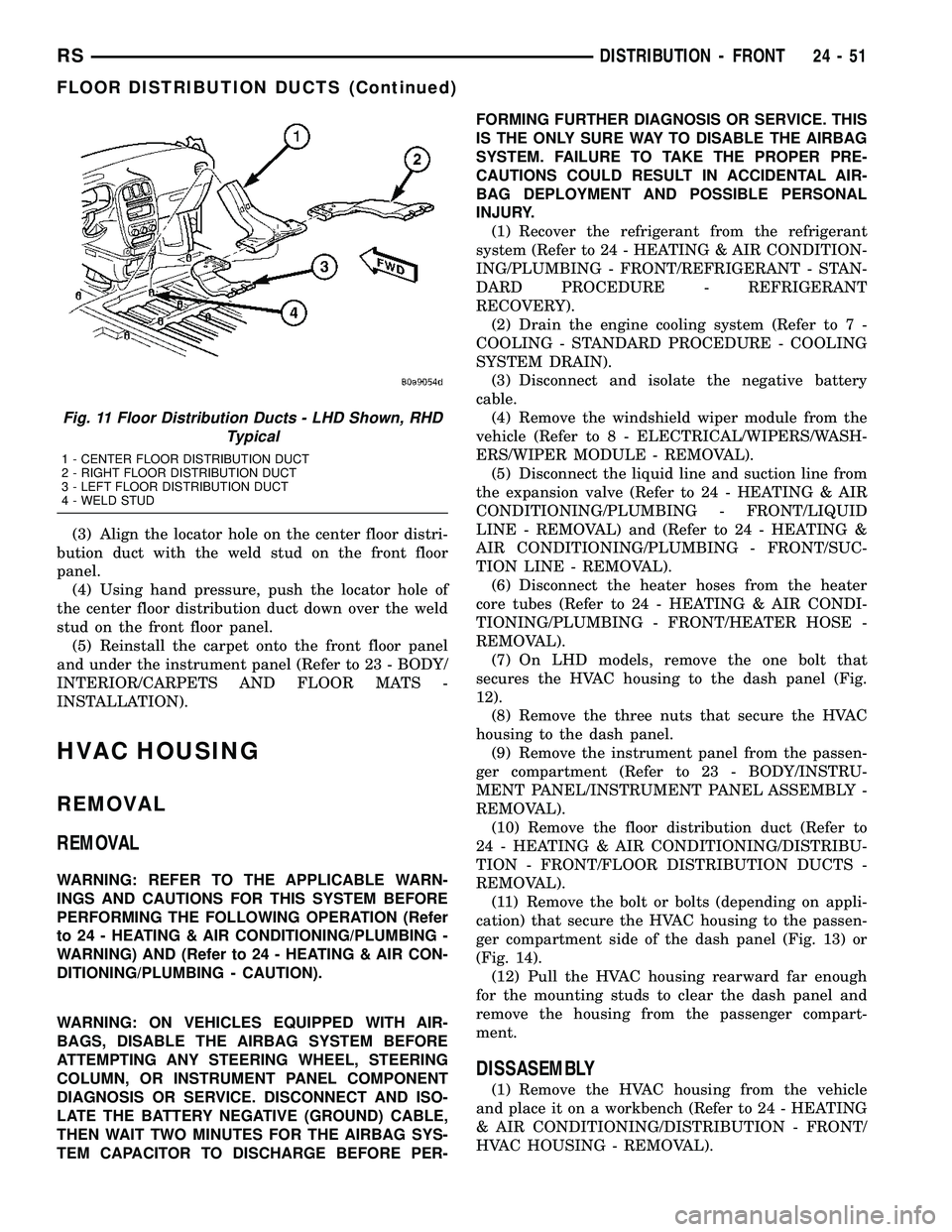
(3) Align the locator hole on the center floor distri-
bution duct with the weld stud on the front floor
panel.
(4) Using hand pressure, push the locator hole of
the center floor distribution duct down over the weld
stud on the front floor panel.
(5) Reinstall the carpet onto the front floor panel
and under the instrument panel (Refer to 23 - BODY/
INTERIOR/CARPETS AND FLOOR MATS -
INSTALLATION).
HVAC HOUSING
REMOVAL
REMOVAL
WARNING: REFER TO THE APPLICABLE WARN-
INGS AND CAUTIONS FOR THIS SYSTEM BEFORE
PERFORMING THE FOLLOWING OPERATION (Refer
to 24 - HEATING & AIR CONDITIONING/PLUMBING -
WARNING) AND (Refer to 24 - HEATING & AIR CON-
DITIONING/PLUMBING - CAUTION).
WARNING: ON VEHICLES EQUIPPED WITH AIR-
BAGS, DISABLE THE AIRBAG SYSTEM BEFORE
ATTEMPTING ANY STEERING WHEEL, STEERING
COLUMN, OR INSTRUMENT PANEL COMPONENT
DIAGNOSIS OR SERVICE. DISCONNECT AND ISO-
LATE THE BATTERY NEGATIVE (GROUND) CABLE,
THEN WAIT TWO MINUTES FOR THE AIRBAG SYS-
TEM CAPACITOR TO DISCHARGE BEFORE PER-FORMING FURTHER DIAGNOSIS OR SERVICE. THIS
IS THE ONLY SURE WAY TO DISABLE THE AIRBAG
SYSTEM. FAILURE TO TAKE THE PROPER PRE-
CAUTIONS COULD RESULT IN ACCIDENTAL AIR-
BAG DEPLOYMENT AND POSSIBLE PERSONAL
INJURY.
(1) Recover the refrigerant from the refrigerant
system (Refer to 24 - HEATING & AIR CONDITION-
ING/PLUMBING - FRONT/REFRIGERANT - STAN-
DARD PROCEDURE - REFRIGERANT
RECOVERY).
(2) Drain the engine cooling system (Refer to 7 -
COOLING - STANDARD PROCEDURE - COOLING
SYSTEM DRAIN).
(3) Disconnect and isolate the negative battery
cable.
(4) Remove the windshield wiper module from the
vehicle (Refer to 8 - ELECTRICAL/WIPERS/WASH-
ERS/WIPER MODULE - REMOVAL).
(5) Disconnect the liquid line and suction line from
the expansion valve (Refer to 24 - HEATING & AIR
CONDITIONING/PLUMBING - FRONT/LIQUID
LINE - REMOVAL) and (Refer to 24 - HEATING &
AIR CONDITIONING/PLUMBING - FRONT/SUC-
TION LINE - REMOVAL).
(6) Disconnect the heater hoses from the heater
core tubes (Refer to 24 - HEATING & AIR CONDI-
TIONING/PLUMBING - FRONT/HEATER HOSE -
REMOVAL).
(7) On LHD models, remove the one bolt that
secures the HVAC housing to the dash panel (Fig.
12).
(8) Remove the three nuts that secure the HVAC
housing to the dash panel.
(9) Remove the instrument panel from the passen-
ger compartment (Refer to 23 - BODY/INSTRU-
MENT PANEL/INSTRUMENT PANEL ASSEMBLY -
REMOVAL).
(10) Remove the floor distribution duct (Refer to
24 - HEATING & AIR CONDITIONING/DISTRIBU-
TION - FRONT/FLOOR DISTRIBUTION DUCTS -
REMOVAL).
(11) Remove the bolt or bolts (depending on appli-
cation) that secure the HVAC housing to the passen-
ger compartment side of the dash panel (Fig. 13) or
(Fig. 14).
(12) Pull the HVAC housing rearward far enough
for the mounting studs to clear the dash panel and
remove the housing from the passenger compart-
ment.
DISSASEMBLY
(1) Remove the HVAC housing from the vehicle
and place it on a workbench (Refer to 24 - HEATING
& AIR CONDITIONING/DISTRIBUTION - FRONT/
HVAC HOUSING - REMOVAL).
Fig. 11 Floor Distribution Ducts - LHD Shown, RHD
Typical
1 - CENTER FLOOR DISTRIBUTION DUCT
2 - RIGHT FLOOR DISTRIBUTION DUCT
3 - LEFT FLOOR DISTRIBUTION DUCT
4 - WELD STUD
RSDISTRIBUTION - FRONT24-51
FLOOR DISTRIBUTION DUCTS (Continued)
Page 2449 of 2585
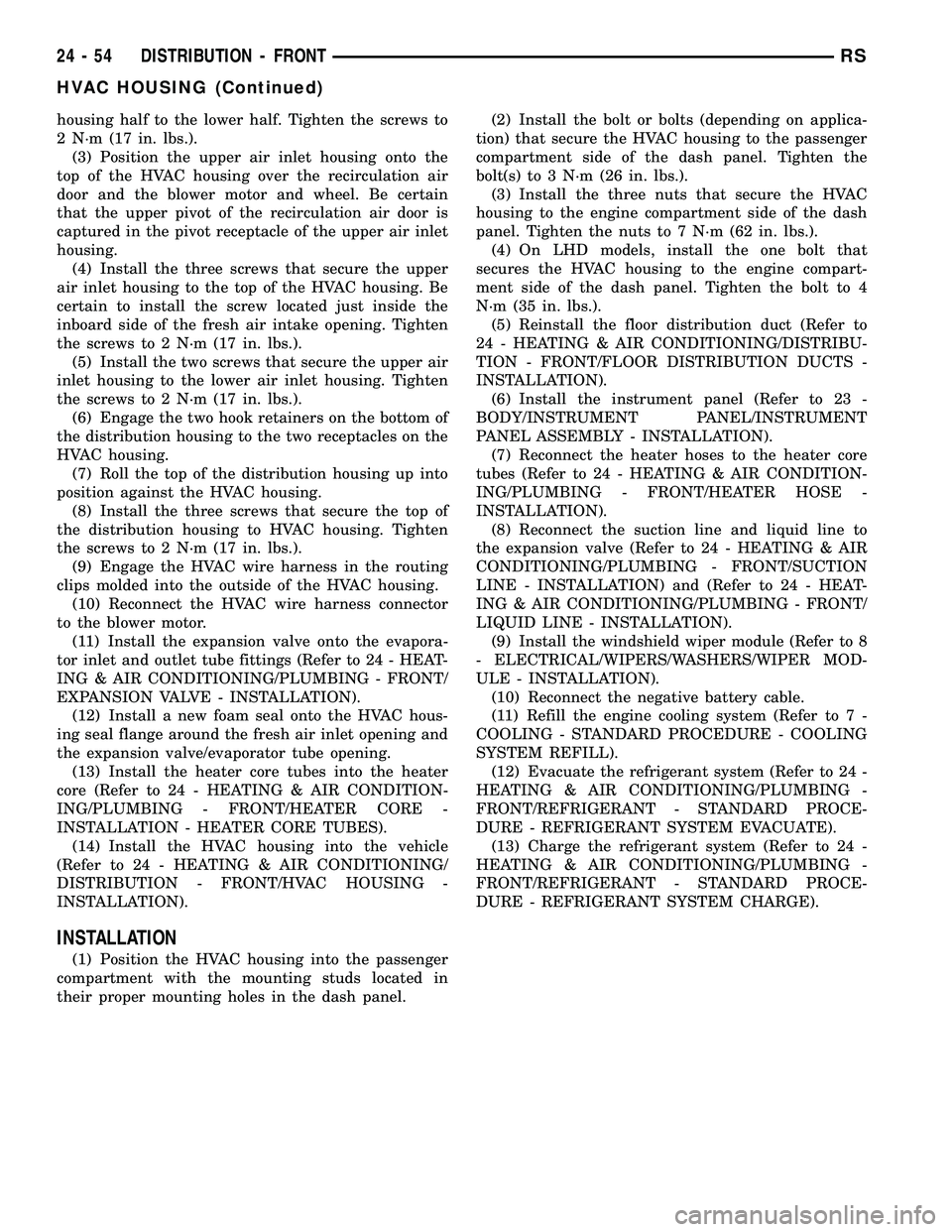
housing half to the lower half. Tighten the screws to
2 N´m (17 in. lbs.).
(3) Position the upper air inlet housing onto the
top of the HVAC housing over the recirculation air
door and the blower motor and wheel. Be certain
that the upper pivot of the recirculation air door is
captured in the pivot receptacle of the upper air inlet
housing.
(4) Install the three screws that secure the upper
air inlet housing to the top of the HVAC housing. Be
certain to install the screw located just inside the
inboard side of the fresh air intake opening. Tighten
the screws to 2 N´m (17 in. lbs.).
(5) Install the two screws that secure the upper air
inlet housing to the lower air inlet housing. Tighten
the screws to 2 N´m (17 in. lbs.).
(6) Engage the two hook retainers on the bottom of
the distribution housing to the two receptacles on the
HVAC housing.
(7) Roll the top of the distribution housing up into
position against the HVAC housing.
(8) Install the three screws that secure the top of
the distribution housing to HVAC housing. Tighten
the screws to 2 N´m (17 in. lbs.).
(9) Engage the HVAC wire harness in the routing
clips molded into the outside of the HVAC housing.
(10) Reconnect the HVAC wire harness connector
to the blower motor.
(11) Install the expansion valve onto the evapora-
tor inlet and outlet tube fittings (Refer to 24 - HEAT-
ING & AIR CONDITIONING/PLUMBING - FRONT/
EXPANSION VALVE - INSTALLATION).
(12) Install a new foam seal onto the HVAC hous-
ing seal flange around the fresh air inlet opening and
the expansion valve/evaporator tube opening.
(13) Install the heater core tubes into the heater
core (Refer to 24 - HEATING & AIR CONDITION-
ING/PLUMBING - FRONT/HEATER CORE -
INSTALLATION - HEATER CORE TUBES).
(14) Install the HVAC housing into the vehicle
(Refer to 24 - HEATING & AIR CONDITIONING/
DISTRIBUTION - FRONT/HVAC HOUSING -
INSTALLATION).
INSTALLATION
(1) Position the HVAC housing into the passenger
compartment with the mounting studs located in
their proper mounting holes in the dash panel.(2) Install the bolt or bolts (depending on applica-
tion) that secure the HVAC housing to the passenger
compartment side of the dash panel. Tighten the
bolt(s) to 3 N´m (26 in. lbs.).
(3) Install the three nuts that secure the HVAC
housing to the engine compartment side of the dash
panel. Tighten the nuts to 7 N´m (62 in. lbs.).
(4) On LHD models, install the one bolt that
secures the HVAC housing to the engine compart-
ment side of the dash panel. Tighten the bolt to 4
N´m (35 in. lbs.).
(5) Reinstall the floor distribution duct (Refer to
24 - HEATING & AIR CONDITIONING/DISTRIBU-
TION - FRONT/FLOOR DISTRIBUTION DUCTS -
INSTALLATION).
(6) Install the instrument panel (Refer to 23 -
BODY/INSTRUMENT PANEL/INSTRUMENT
PANEL ASSEMBLY - INSTALLATION).
(7) Reconnect the heater hoses to the heater core
tubes (Refer to 24 - HEATING & AIR CONDITION-
ING/PLUMBING - FRONT/HEATER HOSE -
INSTALLATION).
(8) Reconnect the suction line and liquid line to
the expansion valve (Refer to 24 - HEATING & AIR
CONDITIONING/PLUMBING - FRONT/SUCTION
LINE - INSTALLATION) and (Refer to 24 - HEAT-
ING & AIR CONDITIONING/PLUMBING - FRONT/
LIQUID LINE - INSTALLATION).
(9) Install the windshield wiper module (Refer to 8
- ELECTRICAL/WIPERS/WASHERS/WIPER MOD-
ULE - INSTALLATION).
(10) Reconnect the negative battery cable.
(11) Refill the engine cooling system (Refer to 7 -
COOLING - STANDARD PROCEDURE - COOLING
SYSTEM REFILL).
(12) Evacuate the refrigerant system (Refer to 24 -
HEATING & AIR CONDITIONING/PLUMBING -
FRONT/REFRIGERANT - STANDARD PROCE-
DURE - REFRIGERANT SYSTEM EVACUATE).
(13) Charge the refrigerant system (Refer to 24 -
HEATING & AIR CONDITIONING/PLUMBING -
FRONT/REFRIGERANT - STANDARD PROCE-
DURE - REFRIGERANT SYSTEM CHARGE).
24 - 54 DISTRIBUTION - FRONTRS
HVAC HOUSING (Continued)
Page 2582 of 2585
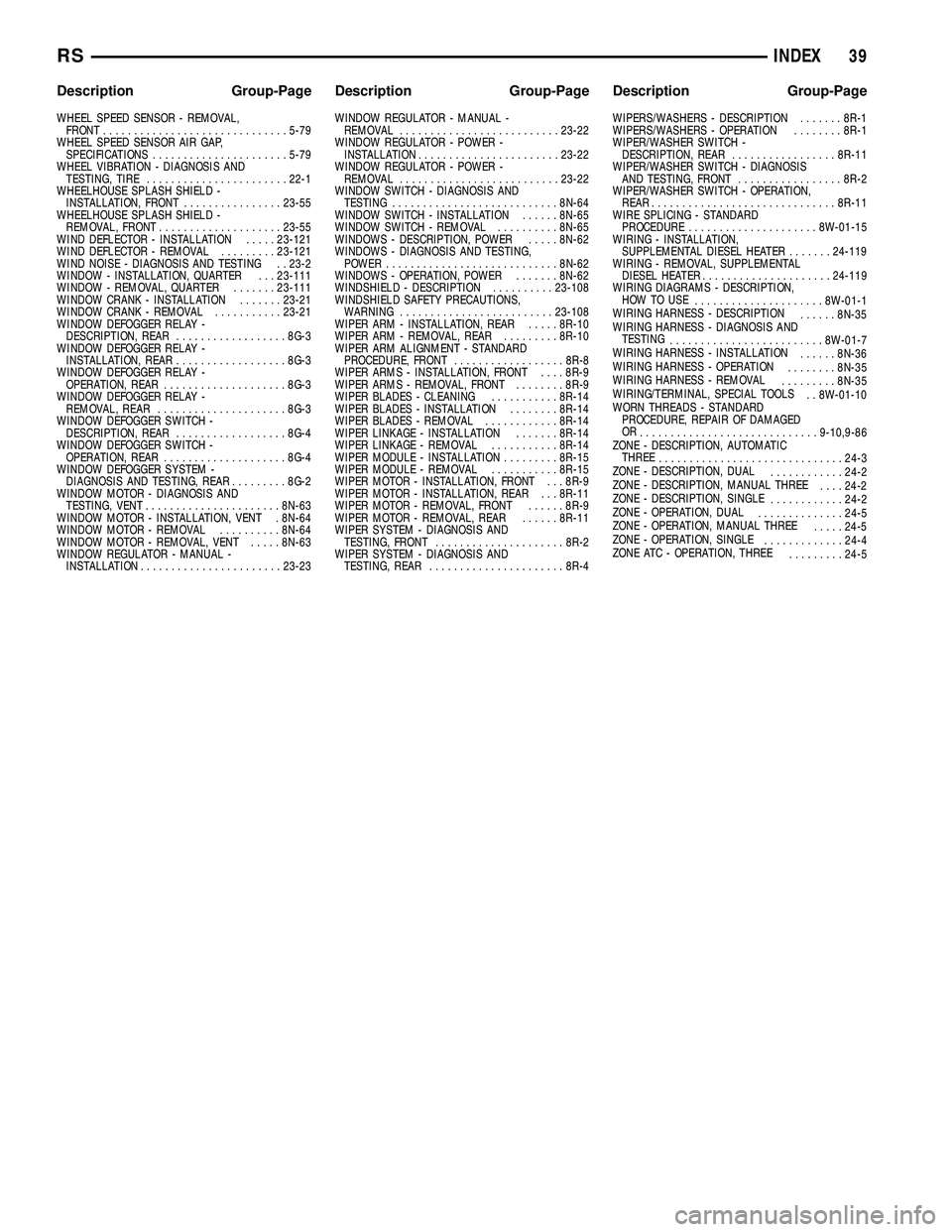
WHEEL SPEED SENSOR - REMOVAL,
FRONT..............................5-79
WHEEL SPEED SENSOR AIR GAP,
SPECIFICATIONS......................5-79
WHEEL VIBRATION - DIAGNOSIS AND
TESTING, TIRE.......................22-1
WHEELHOUSE SPLASH SHIELD -
INSTALLATION, FRONT................23-55
WHEELHOUSE SPLASH SHIELD -
REMOVAL, FRONT....................23-55
WIND DEFLECTOR - INSTALLATION.....23-121
WIND DEFLECTOR - REMOVAL.........23-121
WIND NOISE - DIAGNOSIS AND TESTING . . 23-2
WINDOW - INSTALLATION, QUARTER . . . 23-111
WINDOW - REMOVAL, QUARTER.......23-111
WINDOW CRANK - INSTALLATION.......23-21
WINDOW CRANK - REMOVAL...........23-21
WINDOW DEFOGGER RELAY -
DESCRIPTION, REAR..................8G-3
WINDOW DEFOGGER RELAY -
INSTALLATION, REAR..................8G-3
WINDOW DEFOGGER RELAY -
OPERATION, REAR....................8G-3
WINDOW DEFOGGER RELAY -
REMOVAL, REAR.....................8G-3
WINDOW DEFOGGER SWITCH -
DESCRIPTION, REAR..................8G-4
WINDOW DEFOGGER SWITCH -
OPERATION, REAR....................8G-4
WINDOW DEFOGGER SYSTEM -
DIAGNOSIS AND TESTING, REAR.........8G-2
WINDOW MOTOR - DIAGNOSIS AND
TESTING, VENT......................8N-63
WINDOW MOTOR - INSTALLATION, VENT . 8N-64
WINDOW MOTOR - REMOVAL..........8N-64
WINDOW MOTOR - REMOVAL, VENT.....8N-63
WINDOW REGULATOR - MANUAL -
INSTALLATION.......................23-23WINDOW REGULATOR - MANUAL -
REMOVAL..........................23-22
WINDOW REGULATOR - POWER -
INSTALLATION.......................23-22
WINDOW REGULATOR - POWER -
REMOVAL..........................23-22
WINDOW SWITCH - DIAGNOSIS AND
TESTING...........................8N-64
WINDOW SWITCH - INSTALLATION......8N-65
WINDOW SWITCH - REMOVAL..........8N-65
WINDOWS - DESCRIPTION, POWER.....8N-62
WINDOWS - DIAGNOSIS AND TESTING,
POWER............................8N-62
WINDOWS - OPERATION, POWER.......8N-62
WINDSHIELD - DESCRIPTION..........23-108
WINDSHIELD SAFETY PRECAUTIONS,
WARNING.........................23-108
WIPER ARM - INSTALLATION, REAR.....8R-10
WIPER ARM - REMOVAL, REAR.........8R-10
WIPER ARM ALIGNMENT - STANDARD
PROCEDURE, FRONT..................8R-8
WIPER ARMS - INSTALLATION, FRONT....8R-9
WIPER ARMS - REMOVAL, FRONT........8R-9
WIPER BLADES - CLEANING...........8R-14
WIPER BLADES - INSTALLATION........8R-14
WIPER BLADES - REMOVAL............8R-14
WIPER LINKAGE - INSTALLATION.......8R-14
WIPER LINKAGE - REMOVAL...........8R-14
WIPER MODULE - INSTALLATION.........8R-15
WIPER MODULE - REMOVAL...........8R-15
WIPER MOTOR - INSTALLATION, FRONT . . . 8R-9
WIPER MOTOR - INSTALLATION, REAR . . . 8R-11
WIPER MOTOR - REMOVAL, FRONT......8R-9
WIPER MOTOR - REMOVAL, REAR......8R-11
WIPER SYSTEM - DIAGNOSIS AND
TESTING, FRONT.....................8R-2
WIPER SYSTEM - DIAGNOSIS AND
TESTING, REAR......................8R-4WIPERS/WASHERS - DESCRIPTION.......8R-1
WIPERS/WASHERS - OPERATION........8R-1
WIPER/WASHER SWITCH -
DESCRIPTION, REAR.................8R-11
WIPER/WASHER SWITCH - DIAGNOSIS
AND TESTING, FRONT.................8R-2
WIPER/WASHER SWITCH - OPERATION,
REAR..............................8R-11
WIRE SPLICING - STANDARD
PROCEDURE.....................8W-01-15
WIRING - INSTALLATION,
SUPPLEMENTAL DIESEL HEATER.......24-119
WIRING - REMOVAL, SUPPLEMENTAL
DIESEL HEATER.....................24-119
WIRING DIAGRAMS - DESCRIPTION,
HOW TO USE
.....................8W-01-1
WIRING HARNESS - DESCRIPTION
......8N-35
WIRING HARNESS - DIAGNOSIS AND
TESTING
.........................8W-01-7
WIRING HARNESS - INSTALLATION
......8N-36
WIRING HARNESS - OPERATION
........8N-35
WIRING HARNESS - REMOVAL
.........8N-35
WIRING/TERMINAL, SPECIAL TOOLS
. . 8W-01-10
WORN THREADS - STANDARD
PROCEDURE, REPAIR OF DAMAGED
OR
.............................9-10,9-86
ZONE - DESCRIPTION, AUTOMATIC
THREE
..............................24-3
ZONE - DESCRIPTION, DUAL
............24-2
ZONE - DESCRIPTION, MANUAL THREE
....24-2
ZONE - DESCRIPTION, SINGLE
............24-2
ZONE - OPERATION, DUAL
..............24-5
ZONE - OPERATION, MANUAL THREE
.....24-5
ZONE - OPERATION, SINGLE
.............24-4
ZONE ATC - OPERATION, THREE
.........24-5
RSINDEX39
Description Group-Page Description Group-Page Description Group-Page